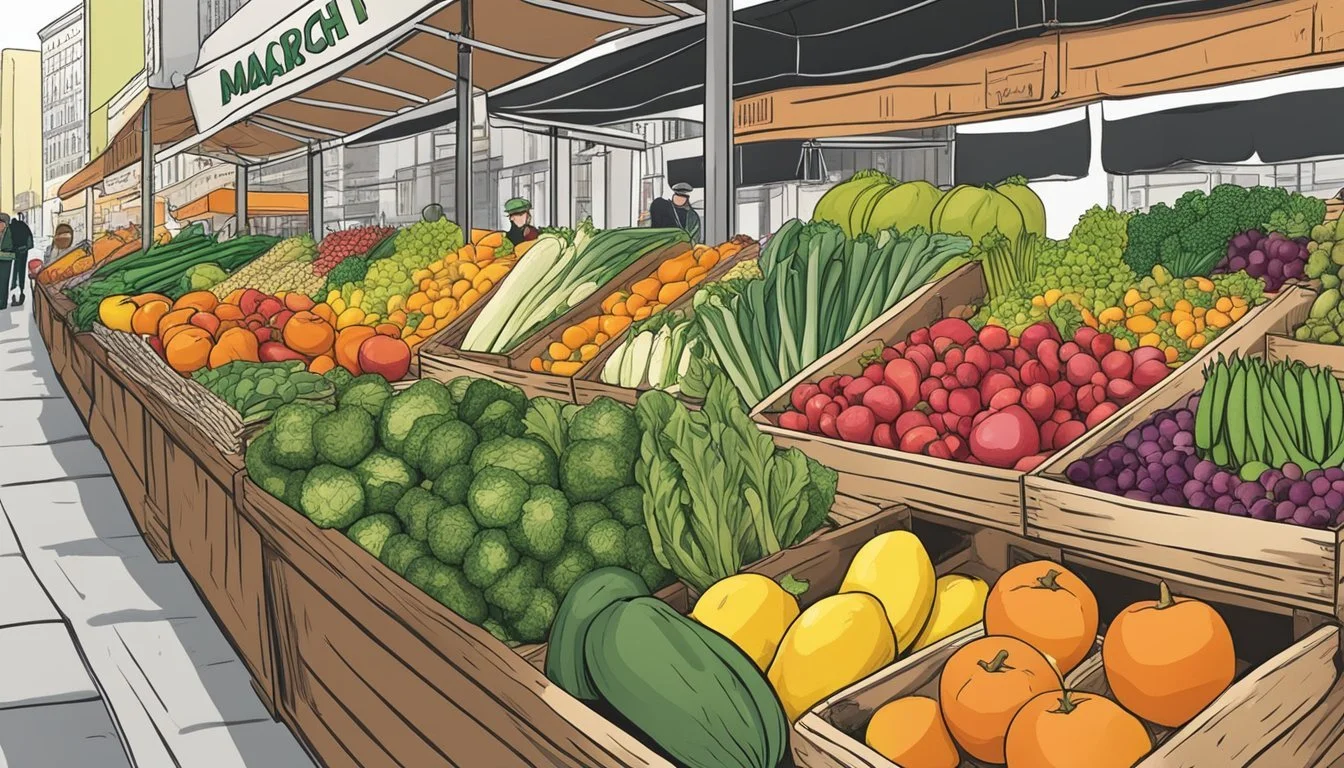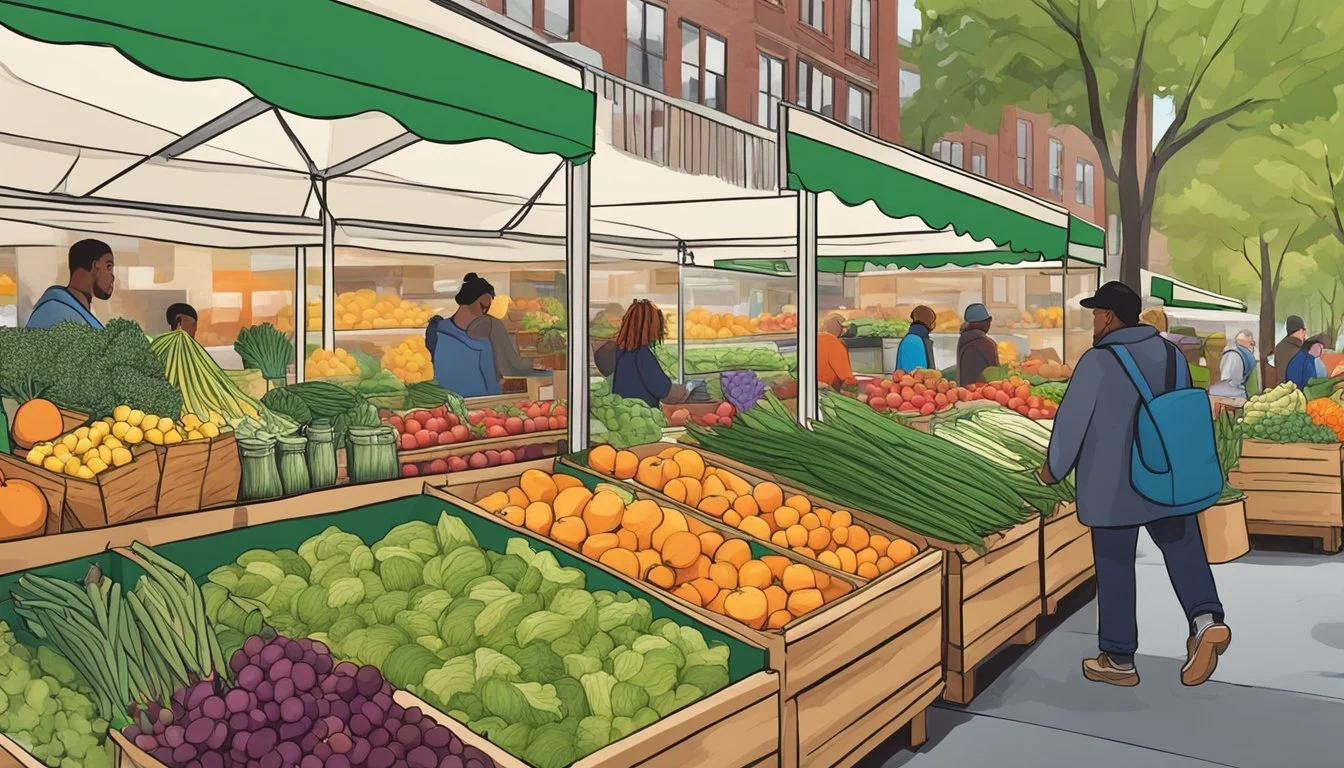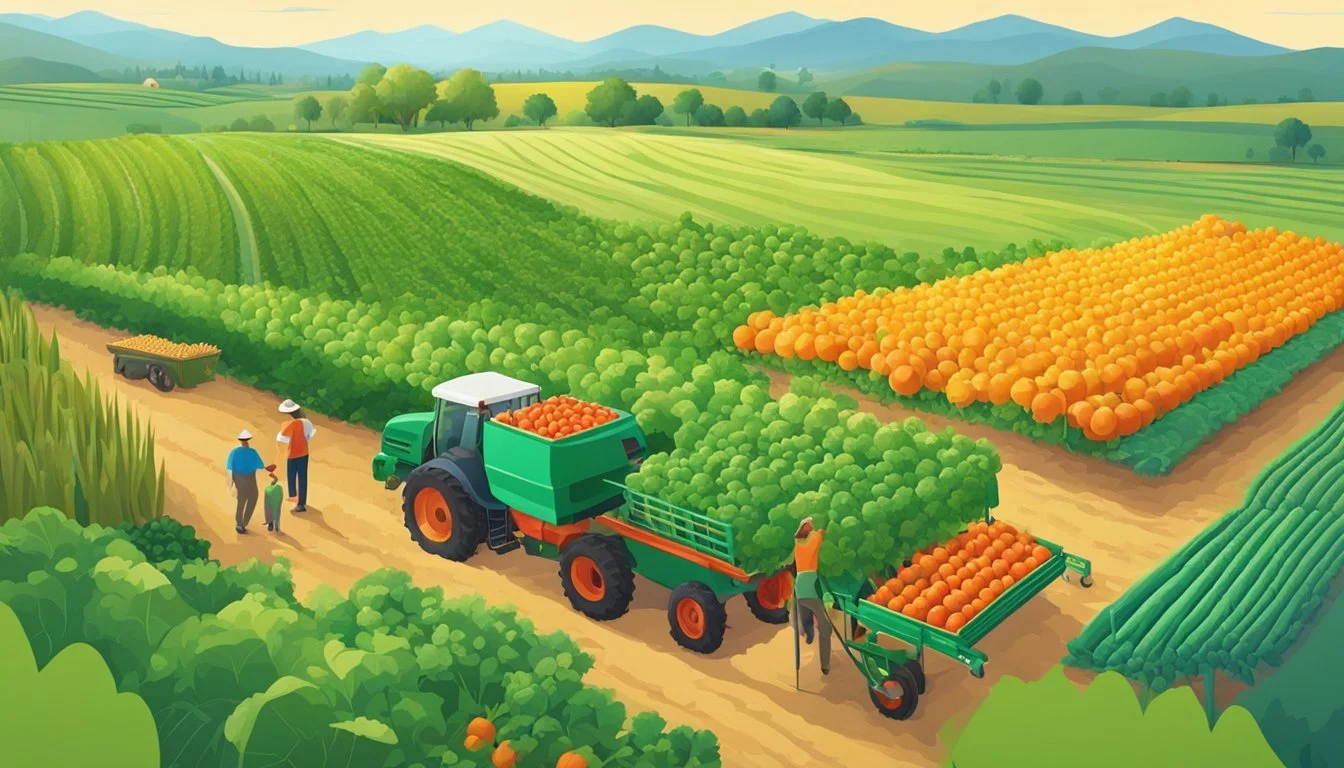New York Seasonal Fruit & Vegetables in March
A Guide to Local Produce
This Article is Part of our New York Seasonal Fruit & Veg Calendar
Exploring the bounty of New York's produce in March reveals a blend of late winter and early spring offerings. As the chill of winter begins to thaw, New York's farms prepare for a modest yet varied selection of fruits and vegetables. During this month, root vegetables and hardy greens are commonly in abundance, sustaining local markets and providing robust flavors that have been nurtured through the colder months.
The transition from winter to spring creates an overlap where the last of winter produce is available alongside the initial arrivals of spring's harvest. New Yorkers seeking fresh, seasonal produce can find items such as carrots, parsnips, and potatoes, which remain staples until the more diverse selection of spring vegetables begin to appear.
Mapping the seasonal produce in New York during March is crucial for consumers aiming to support local agriculture and enjoy fruits and vegetables at their peak freshness. Farming practices and weather variability can influence the availability of certain crops, making it a dynamic time for local produce offerings. Eating seasonally during this period ensures a connection to the local food system and can result in more flavorful, nutritious meals.
New York's Seasonal Climate and Its Impact on Agriculture
As March ushers in the transition from winter to spring, New York's agriculture shifts gears. Farmers prepare for the growing season, closely monitoring the state's weather patterns, which play a crucial role in determining the success of both cool-weather crops and the timeline for planting.
Understanding the Growing Season
New York's growing season typically commences as the frosty grip of winter eases. Cool-weather crops thrive in these early spring conditions, thanks to the state's coordination of planting schedules with temperature trends. As the days gradually warm, farmers look to the expected last frost date to sow seeds that will benefit from the cool start. Vegetables such as lettuce, kale, (What wine goes well with kale?) and peas are among the first to be planted, making the most of the season's unique climate.
March Weather Patterns in New York
March in New York is characterized by rapid climatic shifts that can include late-season snowfalls and early spring warmth. This convergence of winter and spring elements results in a varied temperature landscape. Average high temperatures in March can range from 40°F to 50°F, while lows often dip to freezing points.
Precipitation: Regular rain and occasional snow during this month provide essential moisture needed for soil preparation and early crop growth.
Temperature Fluctuations: Sudden warm spells or frost events can affect budding plants, but these changes are typically anticipated and managed by seasoned farmers.
Daylight Increase: Longer daylight hours contribute to the warming of the soil, signaling the impending kickoff of the growing season.
Farmers in New York State rely on their intimate knowledge of regional climate patterns to optimize planting schedules, ensuring the successful cultivation of seasonal produce.
Seasonal Fruits and Vegetables Available in March
In New York, March heralds the availability of storage crops and the onset of spring harvests, providing a variety of fruits and vegetables fresh from the farm.
Key Fruits to Look For
Apples remain a stalwart choice with certain varieties still available from cold storage that retain their crispness and flavor well past their picking season. Pears, similarly, can be found fresh and flavorful, echoing the final notes of winter's produce.
Apples: Crisp and flavorful
Pears: Fresh and available
Essential Vegetables for March
Vegetables in March are largely representative of hearty produce that stores well or newly sprouting greens that herald the arrival of spring. Carrots and cabbage are root vegetables often available through March, as they keep exceptionally well in cold storage, maintaining their nutritious value and taste.
Carrots: Sweet, nutritious, available from storage
Cabbage: Hearty and available
Early spring offers the beginning of the asparagus (What wine goes well with asparagus?) season, with its tender shoots offering a distinct and desirable taste. Leafy greens such as kale, lettuce, and spinach start to make their appearance, promising freshness and a diversity of flavors.
Asparagus: Tender and flavorful
Broccoli (how long does broccoli last?): Begins to appear
Spinach: Fresh harvests arriving
Lettuce: Varieties of crispness
These greens, along with broccoli, are typically at their peak of flavor and nutritional availability in March, giving consumers not only superior taste but also health benefits.
Farming Practices and Harvest Times
New York's diverse climate allows for a variety of farming practices, focusing on sustainability and seasonality. March is a transitional period, paving the way for the spring harvest of numerous vegetables and late-season storage of winter crops.
Sustainable Farming in New York
Sustainable farming practices in New York are essential in maintaining the health of the land and ensuring a continuous supply of fruits and vegetables. Farmers across the state, especially in regions like upstate New York, employ crop rotation, organic methods, and integrated pest management to cultivate their crops with minimal environmental impact.
Crop Rotation: Utilizing this, farmers can reduce soil erosion and increase soil fertility.
Integrated Pest Management: A combination of biological, cultural, and chemical practices to manage pests without harming the environment.
Harvest Timings and Techniques
In March, while the majority of fresh produce is still to come, certain late-winter and early-spring crops are available which include:
Late-winter crops:
Apples: Stored from fall's harvest, still available in markets.
Carrots: Overwintered varieties may be harvested.
Early-spring crops:
Asparagus: Begins to be available towards the end of the month.
Cabbage: Storage from the winter or early harvests in some cases.
Harvest times for these crops vary depending on microclimates and farm locations. Techniques such as cold storage extend the availability of certain crops like apples beyond their typical harvest season. Early spring crops like asparagus are harvested using traditional methods as they become available with the warming weather.
Locally Grown Versus Imported Produce
In March, the focus on locally grown produce in New York can offer both fresh flavor and community support, while the reliance on imported fruits and vegetables helps fill the gaps left by the seasonality of local agriculture.
Benefits of Eating Local Produce
Farmers Markets: Farmers markets in New York are abundant with local produce, providing consumers with fresh and nutrient-rich fruits and vegetables. These markets support the local economy and reduce the carbon footprint associated with long-distance food transport.
Seasonal Availability: Leafy greens and root vegetables are among the produce that can be grown in New York during early spring. Local greenhouses may also supply a limited variety of other vegetables.
Community Support and Environment:
Eating locally grown produce supports New York farmers and the state's agricultural economy.
Short transport distances for local produce mean reduced greenhouse gas emissions and better air quality.
Challenges with Out-of-Season Imports
Reliance on Imports:
To meet consumer demand for off-season produce, New York imports fruits and vegetables from different regions and countries. This can sometimes result in a trade-off between freshness and the need for a diverse diet year-round.
Quality and Safety:
While imported fruits and vegetables undergo safety screenings, the longer transit time can affect their freshness and nutritional value upon arrival.
The state's reliance on imports makes it subject to global market fluctuations, which can impact availability and prices at the market.
Environmental Concerns:
Imported produce often requires more resources to transport and preserve, resulting in a larger ecological footprint compared to locally sourced goods.
Health and Nutritional Benefits of Seasonal Eating
Eating seasonally provides a wealth of health advantages, stemming from the peak nutritional value of fresh produce. This practice supports not only individual well-being but also environmental sustainability.
Nutritional Advantages of Fresh Produce
Seasonal fruits and vegetables in New York during March offer a burst of flavor and nutrition that is synonymous with spring. As these items are harvested at their peak ripeness, they often contain higher levels of essential vitamins and minerals essential for health. For example, spring produce like leafy greens and root vegetables are rich in fiber, vitamins A and C, and antioxidants. Fruits such as strawberries, which begin to appear in late spring, are loaded with vitamin C and antioxidants that support immune health.
Vitamin Content: Fresh, seasonal produce generally has a higher vitamin content than out-of-season counterparts.
Antioxidants: These protective compounds are abundant in fresh fruits and vegetables.
Fiber: Essential for digestive health, fiber is plentiful in seasonal produce like leafy greens.
Incorporating Seasonal Foods into Diet
Incorporating seasonal foods into one’s diet can be both enjoyable and beneficial. March in New York sees the transition from winter staples to spring offerings, like tender asparagus and sweet peas. One can take advantage of this by including these fresh, raw ingredients into meals, reaping the health benefits they provide. Eating seasonally also encourages a varied diet, which broadens the range of nutrients one consumes.
Variety: Regularly changing eating habits with the seasons adds diversity to the diet.
Freshness: Seasonal produce tends to be fresher, as it can be consumed shortly after harvest.
Local: Eating locally sourced seasonal fruits and vegetables ensures one is getting produce that has not been stored for long periods, which often degrades nutrient content.
By focusing on what is ripe and ready in their region, individuals can maximize the nutritional impact of their meals while supporting local agriculture and reducing their carbon footprint.
Tips for Selecting and Storing Fresh Produce
In New York, March brings the promise of spring and the arrival of fresh, vibrant produce. The key is to choose the best quality fruits and vegetables and employ effective storage techniques to maintain their freshness.
Choosing the Best Quality Fruits and Vegetables
Apples: They should have firm, unbruised skins. Selection typically features late-winter varieties that are crisp and tart.
Asparagus: Look for bright green stalks with tight, compact tips. Asparagus should snap easily when bent.
Cabbage: The heads should be dense and heavy for their size with crisp, tightly packed leaves.
Carrots: Choose carrots that are smooth, firm, and deep in color with no signs of sprouting or wilting.
A shopper should always inspect produce for any signs of spoilage or damage before purchase, ensuring they bring home the freshest options available.
Storage Techniques to Maximize Freshness
Apples: Store them in a cool, dark place or in the refrigerator away from other produce to prevent ethylene gas from hastening spoilage.
Asparagus: Keep the stems moist by wrapping them in a damp paper towel, then place them in a plastic bag in the refrigerator.
Cabbage: It can be stored in the refrigerator, ideally in the crisper drawer, in a loose plastic bag to retain moisture.
Carrots: Remove any greens and store the carrots in a plastic bag with holes in the crisper drawer to maintain humidity.
Proper storage is not just about temperature; it also involves managing humidity levels and airflow to extend the shelf life of produce. Additionally, some fruits and vegetables should be kept separate to prevent premature ripening from ethylene-producing items.
Seasonal Recipes and Cooking Ideas
March in New York presents a delightful opportunity to explore an array of fresh produce through innovative dishes and preservation techniques that epitomize the transition from winter to spring.
Creative Dishes with March Produce
In New York, March is a time when one can enjoy the tender spears of asparagus, which can be blanched, steamed, or roasted with olive oil and a touch of sea salt (how long does sea salt last?). This vegetable pairs well with garlic and bold herbs like thyme or basil, enhancing its natural flavors. The versatile broccoli, often irresistible when roasted, likewise benefits from companionship with strong flavors including red pepper flakes (how long do red pepper flakes last?) or ginger.
A hearty kale or spinach sauté is enriched with the addition of fresh herbs for a robust side dish. Salads become more appealing with the inclusion of crisp lettuce and shredded carrots, providing both texture and color. One might consider a vibrant spin on coleslaw by substituting traditional cabbage with a blend of kale and apples for a sweet crunch.
Table: Sample March Vegetable Pairings & Suggestions
Vegetable Pairings Dish Ideas Asparagus Olive oil, garlic Grilled asparagus (What wine goes well with grilled asparagus?) with a drizzle of balsamic Broccoli Ginger, red pepper Spicy stir-fried broccoli with soy sauce (how long does soy sauce last?) Carrots Basil, honey Glazed carrots with a hint of basil Spinach Garlic, lemon Sautéed spinach with garlic and a squeeze of lemon Kale Apples, vinaigrette Kale salad with sliced apples and a tangy dressing
Preserving the Bounty
Preservation allows the flavors of March produce to be enjoyed well beyond their seasons. Carrots may be pickled with a brine of vinegar, water, and spices to create a crunchy condiment perfect for adding to sandwiches or salads later in the year. Apples retain much of their character when turned into apple butter or canned as pie fillings, offering a taste of early spring in the colder months.
For leafy greens like spinach and kale, blanching and freezing is an effective method to preserve their qualities. They can be thawed and used later in cooked dishes without significant loss of texture or flavor. One can create fragrant herb oils or vinegars by steeping basil or thyme in high-quality oil or vinegar, capturing the essence of March's freshness in a bottle.
Remember to always follow safe canning and preserving practices to ensure food safety.
New York's Food Markets and Community Supported Agriculture
New York offers a myriad of fresh, locally-sourced produce through its vibrant farmers' markets and the structure of Community Supported Agriculture (CSA) programs. These platforms not only connect consumers with seasonal fruits and vegetables but also support the state's agricultural community.
Farmers' Markets
Farmers' markets across New York State, particularly in urban areas like New York City, operate as vital access points for fresh produce, including seasonal fruits and vegetables in March. They serve as direct channels for upstate farms to bring products to the market, ensuring that consumers receive fresh, locally-grown goods. The markets typically operate on specific days of the week and provide a variety of produce choices, with the caveat that March offerings might be less diverse due to the region's growing season.
Example Markets:
Union Square Greenmarket, Manhattan: Open Mondays, Wednesdays, Fridays, and Saturdays year-round.
Grand Army Plaza Greenmarket, Brooklyn: Open Saturdays year-round.
Rochester Public Market, Rochester: Open Tuesdays, Thursdays, and Saturdays year-round.
CSA Programs
Community Supported Agriculture (CSA) programs in New York foster a partnership between local farms and community members. These programs enable consumers to purchase a "share" of the harvest upfront, which can include a variety of vegetables and some fruits that are available in early spring. In return, participants regularly receive portions of fresh produce throughout the season. CSA programs often extend beyond just produce, offering other farm products like dairy and meats.
Example CSA Programs:
Roxbury Farm CSA: Located in Kinderhook, NY, one of the largest CSA providers in the Northeast.
Bx Park East Farmers Market and CSA: Offers enrollment for spring and summer, with distributions on Sundays in the Bronx.
Agricultural Events and Education in March
March in New York brings a focus on agricultural education, marked by events designed to share knowledge and celebrate the end of winter. Attendees can gain insights into seasonal produce through a variety of workshops and tours, as well as seasonal celebrations that welcome the upcoming spring.
Workshops and Tours
During March, several New York State organizations conduct workshops targeting both the state's farmers and the general public. These educational events often include:
Pruning workshops: Attendees learn about proper techniques for fruit trees to prepare for the growing season.
Greenhouse management tours: Local farms open their doors for tours, demonstrating early seeding techniques and plant care in controlled environments.
Seasonal Celebrations
New York's agricultural community often hosts celebrations in March that are centered around the end of the state's cold season and the anticipation of spring planting. Key events may include:
Maple syrup festivals: With the sap beginning to flow, sugar houses across the state invite the public to learn about the syrup-making process and taste the fresh product.
Farmers' markets: Some year-round markets hold special events to highlight winter produce and preview items soon to be in season.
Future Outlook and Sustainability in New York Agriculture
New York State is proactively positioning itself as a leader in sustainable agriculture, adapting to future demands with innovative farming techniques and sustainability initiatives.
Advancements in Farming Techniques
Advancements in New York's farming practices are key to future-proofing the state's agricultural sector. Investment in research and the adoption of technology-driven farming methods aim to increase productivity while reducing environmental impacts. Precision agriculture, incorporating data analysis and real-time monitoring of crop conditions, is being employed to optimize resource use and yield outcomes. New York farmers are adopting climate-smart practices to ensure long-term viability, such as:
Crop rotation and diversification to enhance soil health and biodiversity.
Integrated pest management (IPM) to minimize chemical use.
Deployment of drought-resistant crop varieties to combat the challenges posed by climate change.
Promoting Agricultural Sustainability
New York’s commitment to promoting agricultural sustainability is evident in its support for local farms and food systems. Efforts to create a sustainable and resilient food supply chain include:
Encouraging local produce consumption to reduce transportation emissions and support the local economy.
Supporting resource conservation initiatives, such as water-saving irrigation systems and renewable energy usage, exemplified by solar-powered farming operations.
Implementing educational programs aimed at fostering sustainable farming knowledge among producers and consumers.
The integration of these sustainable practices demonstrates New York's dedication to a healthier future for its people and the environment, indicating a robust and resilient agricultural sector for years to come.











